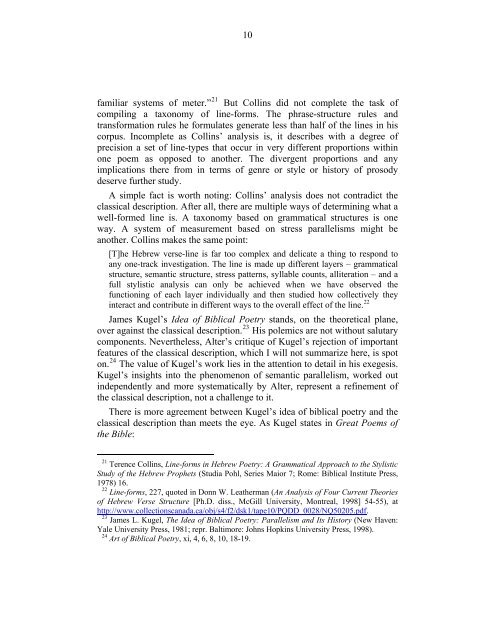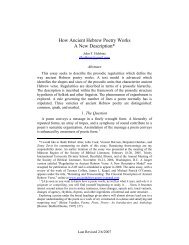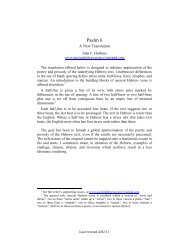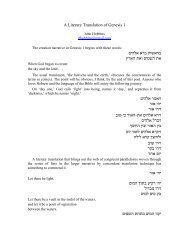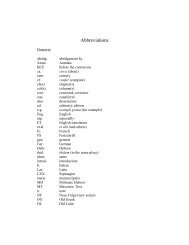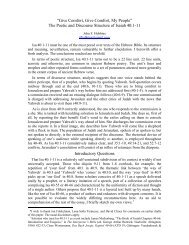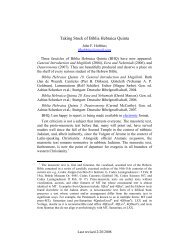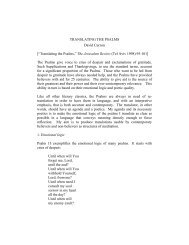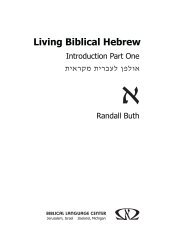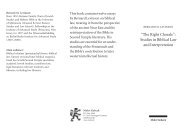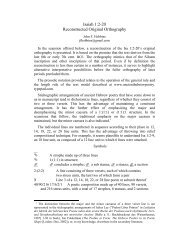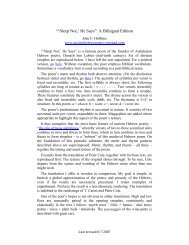Here - Ancient Hebrew Poetry - Typepad
Here - Ancient Hebrew Poetry - Typepad
Here - Ancient Hebrew Poetry - Typepad
- No tags were found...
You also want an ePaper? Increase the reach of your titles
YUMPU automatically turns print PDFs into web optimized ePapers that Google loves.
10familiar systems of meter.” 21 But Collins did not complete the task ofcompiling a taxonomy of line-forms. The phrase-structure rules andtransformation rules he formulates generate less than half of the lines in hiscorpus. Incomplete as Collins’ analysis is, it describes with a degree ofprecision a set of line-types that occur in very different proportions withinone poem as opposed to another. The divergent proportions and anyimplications there from in terms of genre or style or history of prosodydeserve further study.A simple fact is worth noting: Collins’ analysis does not contradict theclassical description. After all, there are multiple ways of determining what awell-formed line is. A taxonomy based on grammatical structures is oneway. A system of measurement based on stress parallelisms might beanother. Collins makes the same point:[T]he <strong>Hebrew</strong> verse-line is far too complex and delicate a thing to respond toany one-track investigation. The line is made up different layers – grammaticalstructure, semantic structure, stress patterns, syllable counts, alliteration – and afull stylistic analysis can only be achieved when we have observed thefunctioning of each layer individually and then studied how collectively theyinteract and contribute in different ways to the overall effect of the line. 22James Kugel’s Idea of Biblical <strong>Poetry</strong> stands, on the theoretical plane,over against the classical description. 23 His polemics are not without salutarycomponents. Nevertheless, Alter’s critique of Kugel’s rejection of importantfeatures of the classical description, which I will not summarize here, is spoton. 24 The value of Kugel’s work lies in the attention to detail in his exegesis.Kugel’s insights into the phenomenon of semantic parallelism, worked outindependently and more systematically by Alter, represent a refinement ofthe classical description, not a challenge to it.There is more agreement between Kugel’s idea of biblical poetry and theclassical description than meets the eye. As Kugel states in Great Poems ofthe Bible:21 Terence Collins, Line-forms in <strong>Hebrew</strong> <strong>Poetry</strong>: A Grammatical Approach to the StylisticStudy of the <strong>Hebrew</strong> Prophets (Studia Pohl, Series Maior 7; Rome: Biblical Institute Press,1978) 16.22 Line-forms, 227, quoted in Donn W. Leatherman (An Analysis of Four Current Theoriesof <strong>Hebrew</strong> Verse Structure [Ph.D. diss., McGill University, Montreal, 1998] 54-55), athttp://www.collectionscanada.ca/obj/s4/f2/dsk1/tape10/PQDD_0028/NQ50205.pdf.23 James L. Kugel, The Idea of Biblical <strong>Poetry</strong>: Parallelism and Its History (New Haven:Yale University Press, 1981; repr. Baltimore: Johns Hopkins University Press, 1998).24 Art of Biblical <strong>Poetry</strong>, xi, 4, 6, 8, 10, 18-19.


